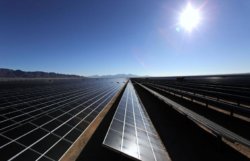When people think of solar power, they tend to think of panels on rooftops.
Strength #2: Predictability The thing about solar power is you know exactly how much it’s going to cost, forever. (At least for the life of a solar PV installation.) Coal and natural gas have highly volatile prices. The price of sunlight is zero. There is no fuel cost. That means the costs of the produced electricity can be calculated in advance, based on capital and operation and maintenance costs. It’s more like building infrastructure than like operating a commodity-based asset. This allows solar developers to offer utilities extremely stable, long-term power purchase agreements, or PPAs. For a utility in these turbulent times, knowing exactly how much power is going to cost for the next 20 (or more) years is a great comfort. That kind of risk hedging is worth money. Here’s a plot of PPA prices over the past several years: This graph makes two things clear. First, almost all new big solar plants in the past few years are PV. And second, power prices are getting extremely low, now regularly falling below $0.05/kWh, or $50/MWh, sometimes as low as $40/MWh. The city of Palo Alto, California, is on the verge of signing a 25-year solar PPA at about $37/MWh, which could well be the cheapest PPA ever signed for solar. The city has the option to extend the PPA to 40 years, which might also make it the longest PPA ever signed. Imagine the peace of mind that comes with knowing you’ve locked in extremely cheap wholesale electricity, at $0.037/kWh, for 40 years. With a stroke, a big source of volatility is eliminated from the budget. One reason big solar PPAs are so cheap is that the federal solar investment tax credit (the ITC) is still in effect and was recently extended, set to phase out over five years. That gives the industry a clear runway to grow past the need for subsidies. And it’s already looking past them. First Solar’s CEO also said, “I fully believe that within 10 years we’ll be talking about low-3-cent power on a peak basis,” without subsidies. That would make big solar the cheapest source of power, period....
Tags: Building Maintenance, Florida Rising Magazine

